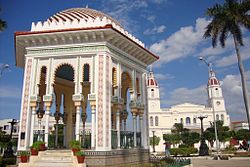You can help expand this article with text translated from the corresponding article in Spanish. Click [show] for important translation instructions.
|
Manzanillo | |
|---|---|
 The Glorieta of Manzanillo | |
 Manzanillo municipality (red) within Granma Province (yellow) and Cuba | |
| Coordinates: 20°20′23″N77°06′31″W / 20.33972°N 77.10861°W | |
| Country | Cuba |
| Province | Granma |
| Established | January 6, 1840 [1] |
| Government | |
| • President | Rossio Naranjo Figueredo |
| Area | |
• Total | 498 km2 (192 sq mi) |
| Elevation | 25 m (82 ft) |
| Population (2022) [3] | |
• Total | 123,542 |
| • Density | 250/km2 (640/sq mi) |
| Demonym | Manzanillero/a |
| Time zone | UTC-5 (EST) |
| Postal code | 87510 |
| Area code | +53 23 |
| Website | https://www.manzanillo.gob.cu/es/ |
Manzanillo is a municipality and city in the Granma Province of Cuba. By population, it is the 14th-largest Cuban city and the most populated one not being a provincial seat.
